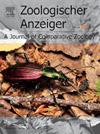保加利亚木海葵与东方海葵的形态变异
IF 1.5
3区 生物学
Q2 ZOOLOGY
引用次数: 0
摘要
在遗传资料的支持下,木门和东方门的物种地位得到了很好的证明,但目前还缺乏基于其他特征来区分这两个分类群的研究。在2021-2024年的交配季节,我们在保加利亚的6个地点共测量了196只树蛙(雄性144只,雌性52只),其中3只在树蛙分布范围内,3只在东方树蛙分布范围内。所有的青蛙都被麻醉,测量,拍照,并在它们完全恢复后在捕获地点释放。我们评估了8个形态特征和相应的指标,并使用统计比较来检验物种和种群水平的变异。虽然有些指标存在显著差异,但结果并不支持物种间明确的形态分离。值得注意的是,有一个种群(Zaychino)在遗传上被鉴定为东方鼠,在形态上与树鼠归为一类。我们的研究结果表明,种间形态差异是微妙的,可能更多地受到当地环境适应或历史渗入的影响。虽然这些结果不足以在野外进行直接的物种鉴定,但有助于更好地了解这两个同属物种之间的形态差异。本文章由计算机程序翻译,如有差异,请以英文原文为准。
Morphological variation between Hyla arborea and Hyla orientalis from Bulgaria
The species status of Hyla arborea and H. orientalis is well supported by genetic data, however, there is still a lack of studies that could differentiate between these taxa based on other characteristics. During the mating season in the period 2021–2024, we measured a total of 196 tree frogs (144 male and 52 female) from six sites – three within the range of H. arborea and three within the range of H. orienatalis in Bulgaria. All frogs were anesthetised, measured, photographed and released at the site of capture after they were fully recovered. We assessed eight morphometric traits and corresponding indices, and used statistical comparisons to examine species- and population-level variation. While some indices showed significant differences, results did not support clear-cut morphological separation between species. Notably, one population (Zaychino), genetically identified as H. orientalis, grouped morphometrically with H. arborea. Our results suggest that interspecific morphological differences are subtle and may be more influenced by local environmental adaptation or historical introgression. Although not sufficient for a direct species identification in the field, the results contribute towards a better understanding of the morphological differences between these two congeneric species.
求助全文
通过发布文献求助,成功后即可免费获取论文全文。
去求助
来源期刊

Zoologischer Anzeiger
生物-动物学
CiteScore
2.80
自引率
7.10%
发文量
75
审稿时长
>12 weeks
期刊介绍:
Zoologischer Anzeiger - A Journal of Comparative Zoology is devoted to comparative zoology with a special emphasis on morphology, systematics, biogeography, and evolutionary biology targeting all metazoans, both modern and extinct. We also consider taxonomic submissions addressing a broader systematic and/or evolutionary context. The overall aim of the journal is to contribute to our understanding of the organismic world from an evolutionary perspective.
The journal Zoologischer Anzeiger invites suggestions for special issues. Interested parties may contact one of the editors.
 求助内容:
求助内容: 应助结果提醒方式:
应助结果提醒方式:


